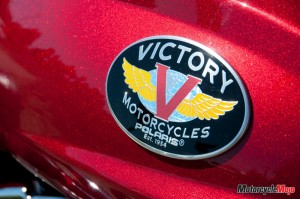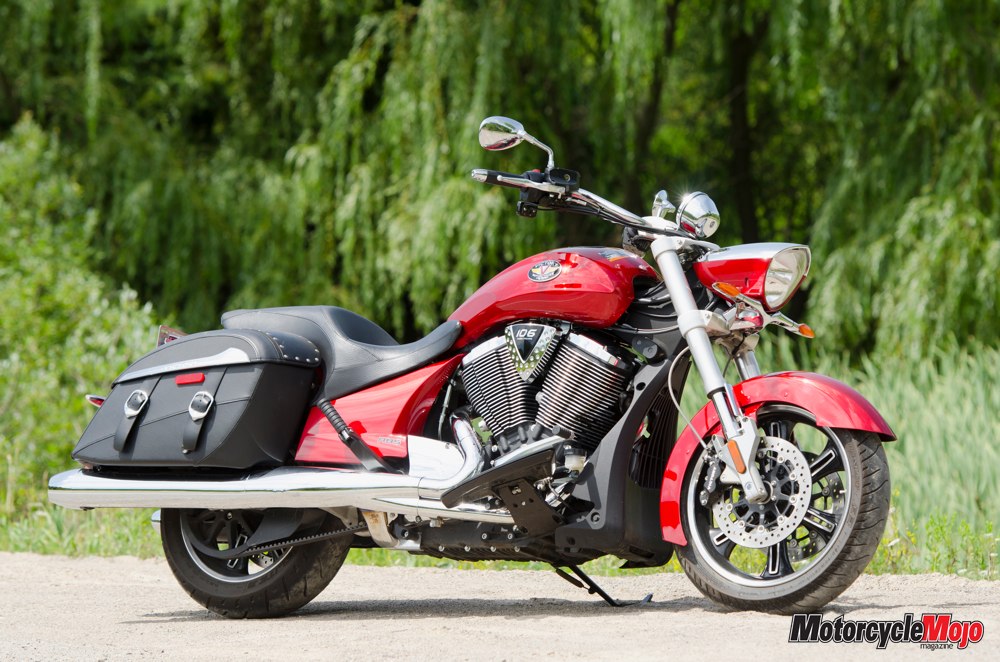Whether heading down the straight and narrow or turning the next corner, the Cross Roads is a capable touring bike that oozes confidence throughout the ride.
Victory has hit a home run with this bagger. The Cross Roads is a minimalist version of Victory’s fairing-clad Cross Country, and while the Cross Roads does have ample storage in its spacious, easy to access,66-litre,leather-clad bags, it does miss out on a few of the amenities that a full fairing has to offer – if you are concerned with a different gauge display and a stereo, that is.
Bells and whistles, while nice at times, are even better when you have the option of whether to use them or not. My Cross Roads demo came with an optional, quick-detachable windshield that was off of the bike most of the time I had it. There’s nothing quite like being able to remove all wind protection and getthe wind in your face on a hot summer day, but with the option tore-attach it in seconds if the weather turns on you – try doing that with a fairing. The Cross Roads boasts a low seat height of only 667 mm (26.25 in.),which allows an easy reach to the ground regardless of inseam measurement, and the bike’s low centre of gravity makes slow-speed handling a breeze, even considering its long wheelbase of 1670 mm (65.7 in.). Equally impressive is the Cross Roads’ high-speed handling. The long bars – if they were rotated up, they would easily fall into the ape-hanger category – stretch way back from the steering head and provide plenty of leverage, making a slight push on the inside handgrip all it takes to lean the bike into a turn.
The Cross Roads boasts a low seat height of only 667 mm (26.25 in.),which allows an easy reach to the ground regardless of inseam measurement, and the bike’s low centre of gravity makes slow-speed handling a breeze, even considering its long wheelbase of 1670 mm (65.7 in.). Equally impressive is the Cross Roads’ high-speed handling. The long bars – if they were rotated up, they would easily fall into the ape-hanger category – stretch way back from the steering head and provide plenty of leverage, making a slight push on the inside handgrip all it takes to lean the bike into a turn.
Powering out of the turn comes easily with a slight twist of the throttle and a thrust of 109 ft-lb of torque from the 106 Freedom V-twin engine. This engine is one of my favourite components of the whole Victory line-up and always provides plenty of entertainment. While the engine easily powers out of corners, it is certainly no wimp on the highway either. The engine lopes along at only 1750 rpm at 80 km/h in sixth gear, but when you want to pass obstacles in your way, it only takes a twist of the grip to make the pass – no downshift required. But sixth gear is an overdrive, so to make the passing experience more fun, clicking down a gear or two makes very short work of the overtake.The only vibration I felt was in the seat and handlebar;this began around 4000 rpm and became slightly more pronounced above 4300 rpm. Chances are you would rarely ever feel it, as the big V-twin is happy to spend its time in the lower rpm range.
The non-adjustable clutch lever requires a firm pull. It is fine for normal, everyday riding, but I wouldn’t want to be stuck in stop-and-go traffic with it. Likewise, the 6-speed transmission needs a sturdy prod to shift. As with most large-displacement V-twins, the shifting is heavy but positive – if nothing else, there is no question whether you have made the shift or not. Finding neutral when stopped is never a problem since Victory introduced its “Neutral Assist” a couple of years ago. Neutral Assist will not allow the transmission to shift into second from first when the bike is stopped, thereby stopping the shift process at neutral.
Tipping the scales at 338 kg (745 lb.) dry, the Cross Roads doesn’t pretend to be a lightweight, but its ease of manoeuvrability is exceptional when rolling and, thanks to the low centre of gravity, it’s a breeze to get off of the side stand.
The weight does catch up with you a little as you stop. The pair of solid-mounted, 4-piston calipers that squeeze 300 mm floating rotors up front require a firm squeeze, and while the feel at the 5-position adjustable lever is a little wooden, a fistful of fingers on the lever does a good job of slowing the big bike. The rear 300 mm rotor and two-piston caliper is adequate and works well in concert with the front binders. The Cross Roads also comes standard with ABS, and in the heat of an emergency stop, its activation is quite discreet and goes almost unnoticed.
The Cross Roads provides more than adequate cornering clearance for this style of bike; however, care must be taken with your lean angle, as the long footboards will touch down as you aggressively carve a corner. After I heard the unmistakable sound of metal on pavement, I stopped to make sure it was only the footboard that touched down, and I then realized that they only give up about 15 mm of movement, at which point they may become a pivot point.
The suspension always supplied a comfortable ride. It soaked up all of the bumps that I could throw at it, and it never once bottomed out. The cartridge-type inverted front fork generously gives up 130 mm (5.1 in.) of travel, while the rear’s air-adjustable single shock and constant-rate linkage allows 120 mm (4.7 in.) of movement.
Adding to the comfort of the Cross Roads is the seating position. The wide seat is flat with a bum stop, which offers good, firm support and keeps your pelvis properly aligned with your spine, eliminating the main reason for lower back discomfort. The passenger seat, by the way, is one of the largest rear seats I have seen, in both width and length, and while I didn’t have a passenger with me on the Cross Roads, I have no reason to believe they wouldn’t be comfortable. While testing the 2011 Cross Country, Gwen spent a number of days on the back seat and found the passenger seat, foot position and the rear suspension to be very comfortable for extended periods.
The long handlebar ensures an easy reach, as the handgrips are positioned far enough back to naturally meet your hands. The Cross Roads has a long and wide 22-litre (4.8 gal.) fuel tank, and sitting on the Cross Roads’ saddle looking forward reminded me slightly of the Honda Rune, as the headlight is a long, long way away. This extreme distance from the front wheel might leave one feeling somewhat disconnected from the steering, but once underway, that feeling dissipates.
Also oversized are the forward-position footboards. At 46 cm, they are longer than other bikes in the category but don’t look out of proportion, and offer the rider plenty of room to move their feet without hanging off in all directions.
The view from the cockpit consists of a single, multi-function gauge. At the bottom of the analog speedo resides an LCD screen that displays a fuel gauge at the top and a gear indicator on the left-hand side. On the right is a readout for kilometres, trip meter and tach, selected using a toggle switch activated by your left forefinger. Rounding out the instruments is a clock at the bottom of the screen. The speedo is switchable from km/h to mph, and the position of the numbers does take some getting used to. It is obviously an American bike designed to use mph as its standard speed format, as 60 mph is at the top centre of the gauge, a position unofficially, but usually, reserved for highway speed. While we are on the subject of “what’s up front,” I found it odd that there is no provision for a steering lock of any kind.
Even without a fairing and the usual amenities that the Cross Country comes with, the Cross Roads does have one convenience that is easy to get used to when on the open road for hours – electronic cruise control. It is apparent that the controls are an add-on to the right-side switchgear, and it is a bit of a stretch to operate, but it works flawlessly and is a welcome addition during hours of highway travel.
When you are out on the open road and you happen to find a crossroad, pick a direction and ride off into the sunset. The Cross Roads makes an ideal weekend getaway vehicle and is even perfect for a week or two on the road. The bags are spacious and the seating position is comfortable for rider and pillion, especially if you add a passenger backrest. The fit and finish is spot-on and the whole package really does turn heads when cruising through towns on the road to anywhere and everywhere.
(Specifications Chart)
| MODEL | 2012 Victory Cross Roads |
| List Price | $17,999 |
| Warranty | 1 year |
| Engine Type | 4-stroke 50-degreeV-twin |
| Displacement | 106 ci / 1731 cc |
| Power (claimed) | N/A |
| Torque (claimed) | 147 Nm (109 lb-ft) |
| Bore and Stroke | 101 × 108 mm |
| Compression Ratio | 9.4:1 |
| Fuel Delivery | Electronic fuel injection with dual 45 mm throttle body |
| Transmission | 6-speed overdrive constant mesh |
| Final Drive Type | Carbon fibre reinforced belt |
| Front Suspension | 43 mm inverted cartridge telescopic fork |
| Rear Suspension | Single, mono-tube with constant-rate linkage, air adjustable |
| Wheel Travel | Front: 130 mm (5.1 in.)Rear: 120 mm (4.7 in.) |
| Brakes | Front: Dual 300 mm floating rotor with 4-piston calipers. Rear: 300mm floating rotor with 2-piston caliper. ABS |
| Wheelbase | 65.7 in./1670 mm |
| Rake and Trail | 29 degrees/142 mm |
| Tires | Front: 130/70B-18. Rear: 180/60R-16 |
| Weight (dry) | 338 kg (745 lb.) |
| Seat Height | 667 mm (26.25 in.) |
| Fuel Capacity | 22 L (4.84 gal) |
| Fuel Economy (observed) | 5.88 L/100 km (48 mpg) |
| Fuel Range (estimated) | 374 km |
























